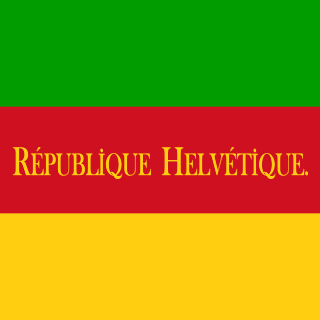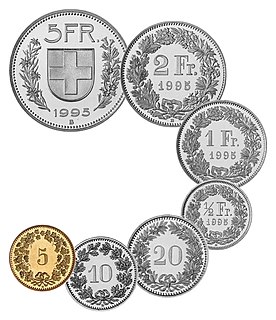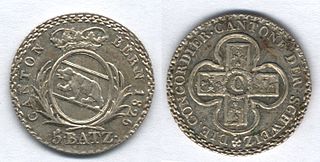
The Frank was the currency of the Swiss canton of Luzern between 1798 and 1850. It was subdivided into 10 Batzen, each of 10 Rappen or 20 Angster.

Switzerland, officially the Swiss Confederation, is a country situated in western, central, and southern Europe. It consists of 26 cantons, and the city of Bern is the seat of the federal authorities. The sovereign state is a federal republic bordered by Italy to the south, France to the west, Germany to the north, and Austria and Liechtenstein to the east. Switzerland is a landlocked country geographically divided between the Alps, the Swiss Plateau and the Jura, spanning a total area of 41,285 km2 (15,940 sq mi). While the Alps occupy the greater part of the territory, the Swiss population of approximately 8.5 million people is concentrated mostly on the plateau, where the largest cities are to be found: among them are the two global cities and economic centres Zürich and Geneva.
The 26 cantons of Switzerland are the member states of the Swiss Confederation. The nucleus of the Swiss Confederacy in the form of the first three confederate allies used to be referred to as the Waldstätte. Two further major steps in the development of the Swiss cantonal system are referred to by the terms Acht Orte and Dreizehn Orte ; they were important intermediate periods of the Ancient Swiss Confederacy.
The Frank was the currency of the Helvetic Republic from 1798, replacing the Gulden in Luzern. The Helvetian Republic ceased issuing coins in 1803 and Luzern once again issued coins its own coins, from 1803 to 1846.

In Swiss history, the Helvetic Republic (1798–1803) represented an early attempt to impose a central authority over Switzerland, which until then had consisted of self-governing cantons united by a loose military alliance.
The gulden was the currency of the Swiss canton of Luzern until 1798. It was subdivided into 40 schilling, each of 3 rappen or 6 angster. Coins were also issued denominated in kreuzer and batzen. It was replaced by the franc of the Helvetic Republic in 1798. This was, in turn, replaced by the Luzern frank.
Copper coins were issued in denominations of 1 Angster and 1 Rappen, together with billon 1⁄2 and 1 Batzen, silver 2 1⁄2, 5 and 10 Batzen and 4 Franken and gold 10 and 20 Franken.
In 1850, the Swiss franc was introduced, with 1 1⁄2 Swiss francs = 1 Luzern Frank.

The franc is the currency and legal tender of Switzerland and Liechtenstein; it is also legal tender in the Italian exclave Campione d'Italia. The Swiss National Bank (SNB) issues banknotes and the federal mint Swissmint issues coins.





